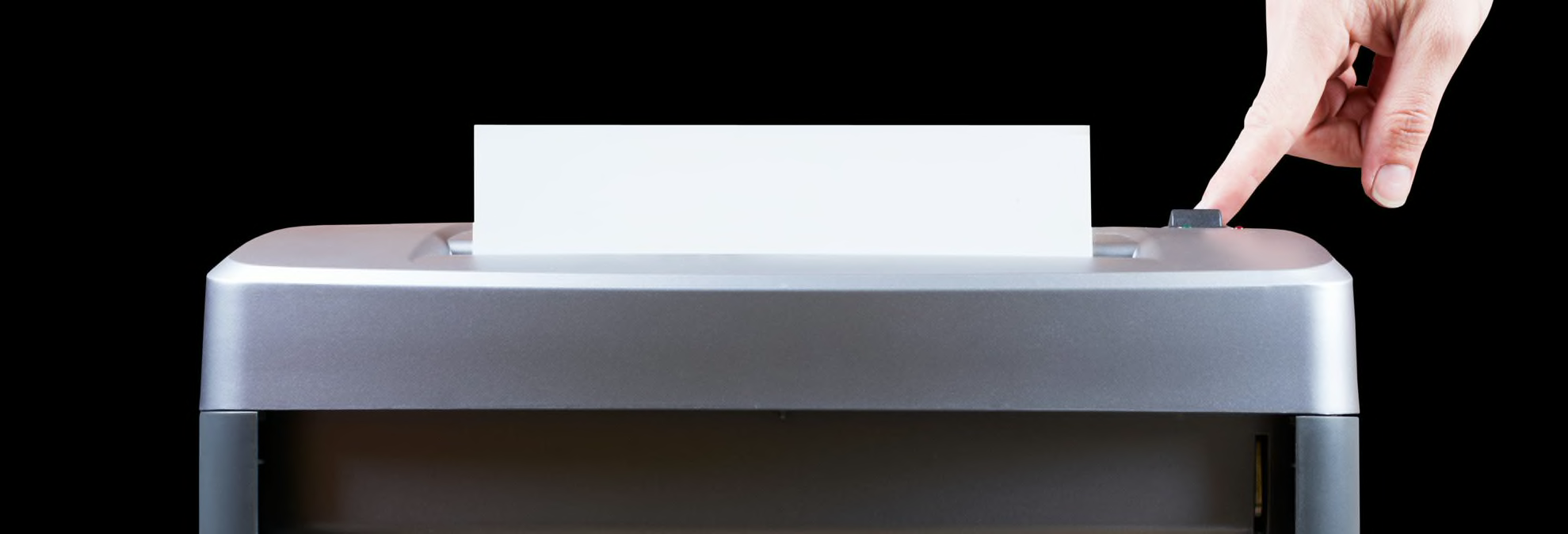
Paper Shredder Buying Guide

Home & Trends Writer
Consider how many sensitive documents you have lying around your home or office that advertise your Social Security number or banking and medical information. Sounds like a breach of privacy waiting to happen, doesn’t it? A paper shredder that you can usually stash under, beside, or even on top of a desk will effectively destroy private documents so that you can dispose of them without the fear of prying eyes or hands gaining access to your information. Some shredders are also equipped to shred credit cards and CDs.
Shredders are available at different prices—from less than $100 to over $300—and vary in terms of speed, capacity, security, and noise levels. Some communities offer monthly, quarterly, or annual paper shredding services, but a personal paper shredder helps mitigate paper clutter that can accumulate.
Because paper shredders aren’t as ubiquitous as, say, refrigerators and microwaves, asking friends for advice on the model you should invest in may not be the most efficient way to do your research. Here’s what you need to know about the most important features so that you can make an informed decision.
How CR Tests Paper Shredders
CR put 14 popular paper shredder models to work in our labs by feeding each with standard 8.5x11-inch printer paper and testing their speed, noise levels, security, and convenience (which includes basket capacity, how easy they are to empty, and whether they’re designed with wheels). While all paper shredders offer security, they don’t all feature the same level of security. The one you choose should meet your personal security expectations and needs. We tested noise levels by placing a decibel meter at ear level for a seated user and running the shredder while it was positioned next to a desk. This data was then collected and considered when giving each of the paper shredders featured on CR an Overall Score.
A Short History of Paper Shredders
Few will be surprised to learn that paper shredders were invented as a way to destroy sensitive information, but its origin story is more provocative than you might expect. An American entrepreneur, Abbott Augustus Low, invented the first paper shredder in 1909. But the German-born Adolf Ehinger gets credit for helping the world understand the benefit of manufacturing this machine when, in 1935, he invented a hand-crank version so that it could destroy anti-Nazi propaganda. The paper shredder was patented, an electric model became available in 1940, and it soon proved to be an indispensable device used by government, military, and banking officials.
The paper shredder’s journey from government office to home office was a rather lengthy one, and most people and small businesses didn’t begin using them until the mid-1980s. The California v. Greenwood Supreme Court ruling in 1988 may have something to do with the device’s popularity boost. This case ruled that the Fourth Amendment didn’t prohibit the warrantless search and seizure of garbage left for collection outside the curtilage of one’s home. A West Virginia University paper published in 1989 responded with the suggestion: “Thus, those who wish to protect themselves from such abuse and to maintain privacy in their garbage must resort to other, more expensive, self-help measures such as an investment in a trash compactor or a paper shredder.”
What Are the Security Levels for Paper Shredders?
This brings us to the present-day paper shredder you’re considering for your security needs, which features far more bells and whistles than its hand-cranked predecessor. The paper shredder that’s right for you will depend a lot on the level of security you need and expect. There are four types of shredders, according to Fellowes, a manufacturer of office equipment. A strip-cut shredder is considered Level P-2 because it provides basic security and shreds pieces of paper into larger strips than the other models. Cross-cut shredders are Levels P-3 and P-4 and offer enhanced security; micro-cut shredders provide superior security and are Levels P-5 and P-6; and high-security shredders are government-approved Level P-7, used to destroy classified and top-secret documents.
What to Look for in a Paper Shredder
Security is paramount, but will your paper shredder fit in your space? Will it wake everyone up on Saturday morning? Here are some other important considerations:
Capacity: This refers to both sheet and bin capacity. Some models can handle numerous sheets of paper at one time, while others require more patience but may be sufficient if you don’t have a lot to shred at once. Always find out the bin’s capacity and how much paper debris it can store in gallons. CR’s favorite paper shredders range in capacity from 8 to 20 sheets with bins from 4 to 8 gallons.
Bin Type: A paper shredder with a pull-out console can be emptied by pulling out a drawer in front that collects paper waste and emptying it into the trash. A wastepaper-basket shredder features a heavy shredding unit that you lift off so that you can empty the basket underneath. All shredders also feature sharp points in the shredders themselves. Lifting the shredding unit off the basket may pose a safety hazard.
Dimensions: You’ll find a range of paper shredders to fit every space, including large models like CR’s top-rated paper shredder, which measures 23 inches tall and can hold 8 gallons of paper. Smaller desktop models are convenient if space is limited, but they might be slower and require you to empty them more frequently.
Noise: The noisiness of your paper shredder may not be a metric you can easily test, especially if you’re ordering one online, but it’s important to keep in mind that there are differences among shredders. CR’s top-rated paper shredders were all chosen for their relative quietness, with the Fellowes Powershred LX22M standing out as the least noisy.
Extras: If it’s important to own a paper shredder that can destroy DVDs and CDs, make sure you look for that feature. All the models we rated will shred credit cards. (If you recycle your paper, you may want to catch the plastic from cards and discs for disposal.) Other perks you’ll find with some models include wheels for portability and an auto-reverse function to clear up paper jams. Paper shredders can overheat after a certain amount of run time, but don’t worry: The shredder will automatically turn off when that happens. A run-time indicator is an additional feature on some models that alerts you when a cool-down period is needed to keep the shredder from overheating.



























